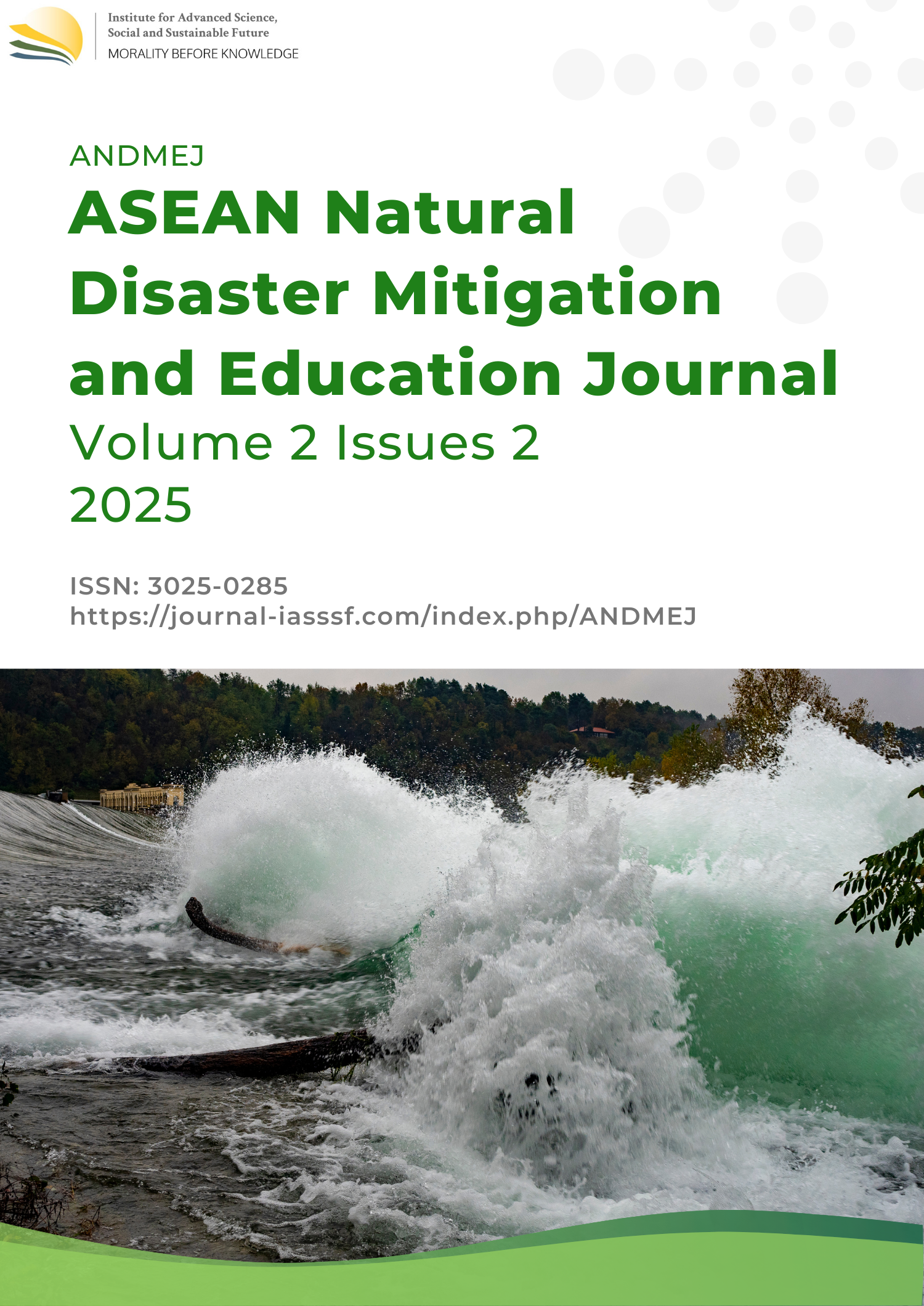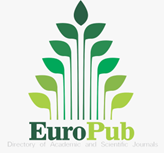Greenhouse gas emission calculation and energy impact of TPS3R flamboyan using waste reduction model (WARM) V.15: Implications for disaster risk reduction
DOI:
https://doi.org/10.61511/andmej.v2i2.2025.1626Keywords:
WARM, CO2, energy use, municipal solid waste, organic wasteAbstract
Background: Human activities contribute to increased greenhouse gas concentrations, such as CO₂ and CH₄, which intensify the greenhouse effect and elevate Earth's temperature. TPS3R Flamboyan aims to reduce plastic waste through recycling, composting, and landfilling at TPA Cipeucang. While these processes help reduce waste, they can also produce CO₂ emissions. This study evaluates the CO₂ emissions from the baseline waste management scenario and compares it with an alternative scenario using the Waste Reduction Model (WARM) to assess GHG emissions and energy use. Methods: Data was collected in June 2020 from TPS3R Flamboyan and TPA Cipeucang in South Tangerang, analyzing waste types and GHG emissions using the WARM software. The study utilized baseline and alternative waste management scenarios to assess CO2 emissions and energy use, with input data on various waste types such as food waste and plastics. WARM compared the emissions and energy use for each scenario, providing insights on GHG reductions and energy efficiency in waste management practices. Findings: Total GHG emissions from baseline MSW generation and management (MTCO2E) is -2.23 and total GHG emissions from alternative MSW Generation ad management (MTCO2E) is -4,46. Total Energy use from baseline MSW Generation and Management (million BTU) is -33.98 and total Energy use from alternative MSW generation and Management (million BTU) is -92.22. Conclusion: Both scenarios indicate that the alternative scenario results in a higher reduction of emissions compared to the baseline management. This demonstrates the effectiveness of the alternative waste management practices in reducing greenhouse gas emissions. Novelty/Originality of this article: This research provides a novel approach by using the Waste Reduction Model (WARM) application, developed by the U.S. Environmental Protection Agency (EPA), to estimate greenhouse gas emissions and energy use in municipal solid waste management scenarios. This application offers high-level estimates for emissions reduction and energy efficiency, providing valuable insights for waste management practices.
References
Alam, P., & Ahmade, K. (2013). Impact of solid waste on health and the environment. International Journal of Sustainable Development and Green Economics (IJSDGE), 2(1), 165-168. https://intelligentjo.com/images/papers/general/waste/impact-of-solid-waste-on-health-and-the-environment
Asnani, P. U. (2006). Solid waste management. India infrastructure report, 570.
Buchdahl, J., Twigg, R., & Cresswell, L. (2002). Global Warming: Fact Sheet Series for Key Stages 2 and 3. Atmosphere, Climate and Environment Information Programme, aris, Manchester Metropolitan University.
Christensen, T. (Ed.). (2011). Solid waste technology and management. John Wiley & Sons.
Culham, W. E., Ali, S. F., & Stahl, C. D. (1969). Experimental and numerical simulation of two-phase flow with interphase mass transfer in one and two dimensions. Society of Petroleum Engineers Journal, 9(03), 323-337. https://doi.org/10.2118/2187-PA
GAW. (2017). WMO greenhouse gas bulletin. GAW
Johnke, B. (2000). Emissions from waste incineration. Good Practice Guidance and Uncertainty Management in National Greenhouse Gas Inventories.
Kadir, A. A. (2012). An overview of wastes recycling in fired clay bricks. International Journal of Integrated Engineering, 4(2). https://penerbit.uthm.edu.my/ojs/index.php/ijie/article/view/224
Khuzzaman, U. A., Rahmayanti, H., & Neolaka, A. (2013). Pengelolaan sampah dengan modifikasi sanitary landfill. Menara: Jurnal Teknik Sipil, 8(1), 11. https://doi.org/10.21009/jmenara.v8i1.8131
Kusumaputri, L. T. (2009). Pengaruh Meningkatnya Konsentrasi Karbondioksida di Atmosfer Terhadap Metabolisme Tanaman. Chimera, 3(2). https://journal.um.ac.id/index.php/chimera/article/view/1576
Nanda, S., & Berruti, F. (2021). Municipal solid waste management and landfilling technologies: a review. Environmental chemistry letters, 19(2), 1433-1456. https://doi.org/10.1007/s10311-020-01100-y
Olivier, J. G., Schure, K. M., & Peters, J. A. H. W. (2017). Trends in global CO2 and total greenhouse gas emissions: 2017 report. PBL Netherlands Environmental Assessment Agency. https://www.pbl.nl/en/publications/trends-in-global-co2-and-total-greenhouse-gas-emissions-2017-report
Osueke, C. O., & Ofondu, I. O. (2011). Study of The Adverse Effect of Aircraft Noise in Nigeria & Discovered Solutions. International Journal of Scientific & Engineering Research, 2(9), 1-4. https://www.ijser.org/viewPaperDetail.aspx?SEP1138
Pratama, N. N., & Saptoadi, H. (2014). Characteristics of waste plastics pyrolytic oil and its applications as alternative fuel on four cylinder diesel engines. International Journal of Renewable Energy Development, 3(1), 13-20. https://doi.org/10.14710/ijred.3.1.13-20
Prayitno. (2007). Reduksi Limbah Padat Dengan Sistem Pembakaran Dalam Tungku Ruang Bakar. https://inis.iaea.org/records/5m2m7-2m434/files/45095781.pdf?download=1
Pujiastuti, D. (2010). Analisis Efek Karbon Dioksida (Co2) Terhadap Kenaikan Temperatur Di Bukit Kota Abang Tahun 2005-2009. Jurnal Ilmu Fisika Universitas Andalas, 2(2), 56-67. http://dx.doi.org/10.25077/jif.2.2.56-67.2010
Rajaeifar, M. A., Ghanavati, H., Dashti, B. B., Heijungs, R., Aghbashlo, M., & Tabatabaei, M. (2017). Electricity generation and GHG emission reduction potentials through different municipal solid waste management technologies: a comparative review. Renewable and Sustainable Energy Reviews, 79, 414-439. https://doi.org/10.1016/j.rser.2017.04.109
Ramlan, M. (2002). Pemanasan global (global warming). Jurnal Teknologi Lingkungan, 3(1), 30-32. https://doi.org/10.29122/jtl.v3i1.233
Susandi, A. (2006). Bencana perubahan iklim global dan proyeksi perubahan iklim Indonesia. Kelompok Keahlian Sains Atmosfer Fakultas Ilmu Kebumian dan Teknologi Mineral ITB.
Suwatanti, E., & Widiyaningrum, P. (2017). Pemanfaatan MOL limbah sayur pada proses pembuatan kompos. Indonesian Journal of Mathematics and Natural Sciences, 40(1), 1-6. https://doi.org/10.15294/ijmns.v40i1.12455
Teller, E., Wood, L., & Hyde, R. (1996). Global warming and ice ages: I. Prospects for physics-based modulation of global change (No. UCRL-JC--128715). Lawrence Livermore National Lab. https://inis.iaea.org/records/cv47n-6j615
Trois, C., & Jagath, R. (2011). Sustained carbon emissions reductions through zero waste strategies for South African municipalities. In Integrated Waste Management-Volume II.
Vergara, S. E., & Tchobanoglous, G. (2012). Municipal solid waste and the environment: a global perspective. Annual review of environment and resources, 37(1), 277-309. https://doi.org/10.1146/annurev-environ-050511-122532
Wahyudi, J., Prayitno, H. T., & Astuti, A. D. (2018). Pemanfaatan limbah plastik sebagai bahan baku pembuatan bahan bakar alternatif. Jurnal Litbang: Media Informasi Penelitian, Pengembangan dan IPTEK, 14(1), 58-67. https://doi.org/10.33658/jl.v14i1.109
Yulipriyanto, H. (2006). Studi Jenis, Komposisi, dan Karakter Sampah di Lingkungan Kampus Universitas Negeri Yogyakarta serta Strategi Pengelolaannya. Jurnal Pendidikan Matematika dan Sains, 11(1), 163-172. https://doi.org/10.21831/jpms.v11i1.12341
Downloads
Published
How to Cite
Issue
Section
Citation Check
License
Copyright (c) 2025 Asrining Ghina Maulidia, Temmy Wikaningrum

This work is licensed under a Creative Commons Attribution 4.0 International License.
















